
A positive safety culture is an organisational environment where safety is a core value which is consistently prioritised by management and employees. It is characterised by open communication about safety issues, mutual respect, and a shared commitment to preventing accidents and injuries. Everyone feels responsible for safety, takes proactive steps to identify and mitigate risks, and encourages others to do the same.
A positive health and safety culture reduces accidents through proactive prevention, continuous improvement and employee engagement.
Here we talk about the advantages of establishing a positive safety culture and provide guidance to help managers to make a positive impact.
Why is it important to establish a positive health and safety culture?
Fatalities at work have fallen by 88% since 1974 when the Health and Safety at Work etc. Act came into force to improve the health and safety culture in organisations across all sectors.
Nevertheless, according to the Health and Safety Executive (HSE), every year about a million employees still suffer work related injuries and millions of working days are lost. Committing to maintaining a positive health and safety culture is vital to reduce these statistics for the benefit of employees and organisations.
Fewer workplace accidents and health issues mean lower costs related to medical expenses, compensation claims, and lost productivity. Employees can focus on their tasks without worrying about their safety, resulting in better overall productivity and operational performance.
Organisations known for positive safety cultures can attract better talent. A positive reputation in this area demonstrates a commitment to corporate social responsibility and ethical practices. It also reduces the risk of fines and legal costs associated with non-compliance.
How can managers promote a positive health and safety culture?
Here are some indicators of a positive safety culture and how managers can make a positive impact:
Proactive risk identification and management
An important aspect of a positive health and safety culture is conducting frequent and thorough risk assessments.
Potential hazards are identified before they lead to accidents and appropriate measures are taken to mitigate risks. Preventative measures might be organising employee training, replacing machinery, changing work processes or providing personal protective equipment, for example.
Provision of safe equipment
Equipment must be fit for purpose, and regularly maintained and inspected. In addition, employees must be competent to use it safely. Employers must comply with PUWER regulations to ensure those who come into contact with equipment and machinery at work are kept safe.
Workstation equipment such as chairs, desks and computers should be designed and positioned so that employees are comfortable and not at risk of developing musculoskeletal disorders.
Poorly designed workstations encourage awkward postures, which can lead to repetitive strain injuries and increased stress. The HSE has a detailed guide to workplace ergonomics. Please also read our guide to working safely with display screen equipment.
Open communication and reporting
It is important that employees know how to report safety concerns, and if concerns are raised, they are thoroughly investigated, and the outcome shared.
Health and safety information and alerts should be shared promptly with employees through clear, efficient communication channels. This information should be available in formats that are accessible to everyone which may include braille and audio versions.
All businesses are legally required to have a health and safety policy which is shared with employees and understood by them. The policy details how an organisation complies with the law and implements procedures to prevent employees and others from suffering harm.
No blame culture
When employees feel comfortable to report near-misses, unsafe conditions and potential hazards without fear of reprisal it means safety issues can be detected and corrected early.
Employers should work with employees to calmly discuss what happened and why. The facts should be examined impartially, and measures implemented to prevent the incident from happening again. Refresher training may need to be provided so employees feel confident to do their jobs safely.
Continuous training and education
Regular training ensures that employees understand safety procedures and protocols. This knowledge helps them recognise and avoid hazards in their daily tasks. By law, employers must provide adequate health and safety training. Trained employees have the skills and knowledge to do their job safely and can feel confident that their employer wants to keep them safe.
Organisations must meet their legal requirements for training. In addition, to ensure employees have the skills they need to perform their jobs safely, it is advisable to regularly consult them to identify whether they would benefit from new or refresher training.
Training does not need to be costly or time-consuming. Online health and safety courses mean employees can complete courses at their own pace from wherever they are.
Our Health and Safety Awareness training ensures employees can identify workplace health and safety hazards and know how to mitigate risks. The course is IOSH Approved and CPD Certified and has been developed by experienced health and safety consultants.
Leading by example
Managers and supervisors should lead by example by following health and safety policies and procedures.
Managers should be accessible and regularly discuss health and safety with their employees. They should demonstrate commitment by their actions, such as stopping work to resolve an incident. This will communicate to employees that their safety takes priority over commercial business interests.
Employee involvement and ownership
All employees should be involved in health and safety planning and conversations. This encourages them to take ownership of their own health and safety and that of others.
When creating new policies and procedures or updating existing ones, it is advisable to consult widely across the workforce, including those who work full-time, part-time and contractors. Employees could also be pro-actively involved in workshops and risk assessments.
Running internal surveys encourages employees to provide feedback and raise concerns about new safety hazards. If employees offer feedback, it is important to respond positively and explain why a suggested action is or is not going to be taken.
Health and safety committees
Creating health and safety committees can help improve health and safety culture in the workplace.
Employers are legally obliged to set up a health and safety committee within three months of it being requested by two or more union-appointed health and safety representatives. There is no such requirement if a business has health and safety representatives elected by the workforce. However, the Health and Safety Executive (HSE) still recommends setting up a health and safety committee.
A health and safety committee helps to encourage open and transparent dialogue between management and employees. The committee can discuss issues including workplace inspections by enforcing authorities, risk assessments and training. They can also discuss accidents with the focus on preventing them from happening again rather than assigning blame.
Recognition of positive safety behaviour
A positive culture promotes and rewards safe behaviour, encouraging employees to consistently follow safety guidelines and take personal responsibility for their actions.
A system for recognising positive health and safety behaviour helps to promote a positive culture. It could involve a prize, sending a personal email or face-to-face praise.
Praxis42’s SHINE learning management system has a feature that allows you to create badges as rewards for users when they complete a course or series of courses.
Continuous improvement
Regular feedback and evaluation of safety practices ensures that organisations continually improve safety measures. Lessons learned from past incidents can enhance future safety protocols.
A proactive safety culture is adaptable and responsive to challenges and changes in the work environment, ensuring that safety measures are always up-to-date and effective.
Creating a positive health and safety culture with IOSH Managing Safely training
IOSH Managing Safely training provides managers with the skills and knowledge to build a positive safety culture in their workplace.
The course fosters a mindset of continuous improvement and empowers managers to lead by example, promoting safety as a core organisational value. Managers are encouraged to ensure effective communication and collaboration among teams, so safety procedures are clearly understood and followed.
By instilling a sense of responsibility and ownership for health and safety at all levels, IOSH Managing Safely helps managers create a safer, more engaged, and productive workplace.
For more details, please see our IOSH Managing Safely course page or contact us on 0203 011 4242/info@praxis42.com





